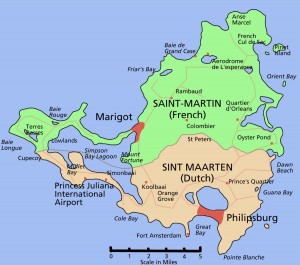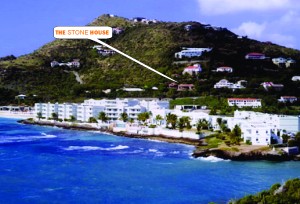Saint Martin is und er the sovereignty of France and the Netherlands. This is the only land border shared by these two countries anywhere on Earth. Located in the Lesser Antilles, at the northern end of the chain, and is a glorious and unique combination of Caribbean charm and European chic.
er the sovereignty of France and the Netherlands. This is the only land border shared by these two countries anywhere on Earth. Located in the Lesser Antilles, at the northern end of the chain, and is a glorious and unique combination of Caribbean charm and European chic.
The main cities are Philipsburg (Dutch side) and Marigot (French side). The Dutch side is more heavily populated. The largest settlement on the entire island is Lower Prince’s Quarter, on the Dutch side.
The highest hilltop is the Pic Paradis in the center of a hill chain on the French side. But both sides are h illy with large mountain peaks. This forms a valley where many houses are located. Hiking trails give access to the dry forest covering tops and slopes.
illy with large mountain peaks. This forms a valley where many houses are located. Hiking trails give access to the dry forest covering tops and slopes.
The island is located just south of Anguilla, separated from the British territory by the Anguilla Channel. Saint Martin is northwest of Saint Barthélemy, separated from the French territory by the Saint-Barthélemy Channel. It is one of the Renaissance Islands.
It is famous for its beautiful beaches (some which are clothing optional), mountains, sunshine, duty-free shopping (jewelry, electronics, European fashions), sailing and water sports of all kinds. Casinos, vibrant nightlight, world-class dining all combine to make the evenings as memorable as the brilliant, lazy days
Definitely not a destination to go sit in one spot for a week – visitors to St. Martin to explore the beaches, restaurants and the many other attractions from one end of the island to the other. Daily island ferry service is available to nearby Anguilla, St. Barths, St. Eustatius and Saba. Oyster Pond offers a ferry service directly to St. Barths. There are numerous sailboat charters for daily or weekly use from Oyster Pond make this harbor an easy choice for water adventures of every type.
The island has a tropical monsoon climate with a dry season from January to April and a rainy season from August to December. The precipitation patterns are due to the movement of the Azores high during the year. Temperatures remain stable throughout the year and temperatures rarely exceed 34 °C (93 °F) or fall below 20 °C (68 °F). The average sea temperature is 27.2 °C (81.0 °F) ranging from a low of 25.9 °C (78.6 °F) in February to a high of 28.4 °C (83.1 °F) in October. The total average yearly rainfall is 1,047 mm (41.2 in), with 142 days of measurable rainfall.